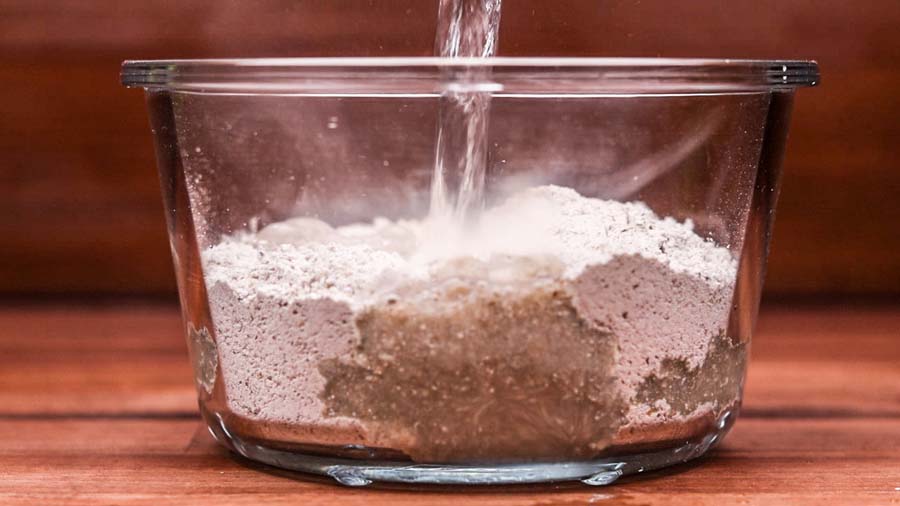Scalding is an old European breadmaking method which is performed by mixing part of the flour in a recipe with boiling water and then letting that mix sit for several hours before adding it to the final dough. It is also adopted and widely used in Asia where it is known as Yudane.
What does scalding achieve?
The main purpose of using this method is to extend the shelf life of bread. But it can also improve the texture of it especially when used alongside other ingredients.
Mixing flour with boiling water essentially cooks it. Starch gelatinizes at a temperature above 65C (150F). During this process liquid is absorbed by the starch which makes it swell up.
The swollen starch can hold more water and it holds on to water a lot better. It allows for the hydration of the final dough to be raised while still achieving the same volume in the resulting bread. The more water is used the longer the bread will take to dry out.
Another benefit of scalding is that it damages the protein in wheat flour weakening the gluten structure which makes the final dough looser and the bread lighter. Think of it as an egg or fat replacement method. It makes for a great alternative in vegan baking.
Fermentation can also be affected by scalding. Enzymes in flour convert damaged starch to into sugar which the yeast then feeds on. Normally starch is damaged during milling. Once we add water to flour the enzymes start their work converting that starch.
Adding boiling water damages the starch even further. Basically, there is more damaged starch to be converted into sugar which means that there will be more sugars for the yeast to eat and thus the fermentation can be accelerated. This could be more effective in whole grain flour as it contains far more enzymes than white flour.
Another side effect of the more abundant sugars is that it can promote the browning of the crust of the bread during baking.
What are the most common uses for scalding?
In European baking scalding is usually reserved for rye breads and other lower gluten flour baked goods. The scalded flour gives added plasticity to the crumb and the crust of the bread which can make such breads softer and bouncier. In the case of low gluten flour scalding can help mimic the presence of gluten by creating a particular texture.
In Asian baking scalding (yudane) is used not only for the plasticity to create a tender and slightly chewy bread, but also for its gluten weakening properties. As mentioned above it can act as a replacement for fats and eggs. But where it really shines is when scalding is used in combination with fat and eggs. The resulting bread can be extremely soft, light, and bouncy. It can stray soft for much longer that way too. Think of Japanese milk bread. I have used this method in quite a few videos so far:
Scalded cold fermented breakfast rolls.
How to convert your favourite recipe to be made with a scald?
Since the scald allows for a higher hydration, that is the first thing to consider. We must increase the amount of liquid in the dough. I have found that a 10% increase in white wheat flour dough is enough to compensate. Whole wheat should get closer to 15% and rye should have an increase of 20% or even more in some cases. It depends on the desired result. And it heavily relies on what other ingredients are used in the recipe.
Generally, around 20% of the flour in any given recipe is used to make the scald.
The proportion of flour to water in the scald can vary depending on the type of flour that is used. For yudane it is suggested to mix it at a 1:1 ratio. But I have found that it makes it quite dry and not very easy to mix. Use a 1:1.4 ratio or higher for white bread flour and 1:2 for whole wheat flour. Rye flour absorbs water a lot better than wheat flour does, so it should be mixed at around 1:3.
All these numbers are not set in stone. They work for me, so I’m simply passing them on.
One final thing to consider is temperature control. Because the scald makes up a significant portion of the total dough mass it can have a significant impact on the final dough temperature.
If your kitchen is warm, then it may be a good idea to refrigerate the scald before adding it to the dough. If your kitchen is cool or even cold, then leaving it at room temperature and then perhaps even using warm water for the final dough may be the best solution.
How to calculate the recipe formula.
The original recipe contained 250g flour, 160g water, 3g yeast, and 5g salt.
The hydration of the original recipe is 64%. 160:250 = 0.64
I increased the hydration by 10% from 64% to 74%. 250 x 0.74 = 185g water.
20% of the total flour was set aside for the scald. 250 x 0.2 = 50g flour.
The scald was mixed with at a 1:1.4 flour to water ratio. 50 x 1.4 = 70g water.
The final formula:
Main dough – 200g flour, 115g water, 3g yeast, 5g salt.
Scald – 50g flour, 70g boiling water.
Total – 250g flour, 185g water, 3g yeast, 5g salt.
The rye bread was calculated using the same equations. The only difference being that the hydration of the dough was increased by 20%.
Watch the video here



